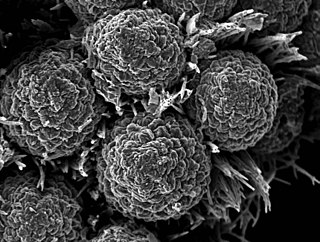Related Research Articles

Sordariomycetes is a class of fungi in the subdivision Pezizomycotina (Ascomycota). It is the second-largest class of Ascomycota, with a worldwide distribution that mostly accommodates terrestrial based taxa, although several can also be found in aquatic habitats. Some are phytopathogens that can cause leaf, stem, and root diseases in a wide variety of hosts, while other genera can cause diseases in arthropods and mammals.

Hypocreomycetidae is a subclass of sac fungi.
Pontogeneia is a genus of fungi within the class Sordariomycetes and Lulworthiomycetidae subclass.
Caudospora is a genus of fungi within the Diaporthales order, class Sordariomycetes. It was later placed in the Sydowiellaceae family.
Kallichroma is a genus of fungi in the class Sordariomycetes which consisted of two species in 2008. In 2023, it contained 4 species.
Phragmitensis is a genus of fungi in the Ascomycota phylum.
Spinulosphaeria is a genus of fungi in the Sordariomycetes class of the Ascomycota. It was placed in 2020, within the Order Coronophorales and in the family of Chaetosphaerellaceae.
The Papulosaceae are a family of fungi in the class Sordariomycetes and in the subclass Diaporthomycetidae. The family has not been assigned to any order. A monotypic taxon, the Papulosaceae contained the single genus Papulosa, which in turn contains the single species Papulosa amerospora. This species, found in the eastern USA, grows in Juncus stems.
Aquaticola is a genus of fungi in the Cephalothecaceae family of the Ascomycota. The relationship of this taxon to other taxa within the Sordariomycetes class is unknown, except that it is in subclass Diaporthomycetidae, and it has not yet been placed with certainty into any order.
Cyanoannulus is a fungal genus in the family Annulatascaceae of the Ascomycota. This is in the monotypic order of Annulatascales of the class Sordariomycetes. It was formerly classed as Sordariomycetes class in 2007.
Fusoidispora is a fungal genus in the Annulatascaceae family of the Ascomycota. The relationship of this taxon to other taxa within the Sordariomycetes class is unknown, except that it is in subclass Diaporthomycetidae, and it has not yet been placed with certainty into any order. This is a monotypic genus, containing the single species Fusoidispora aquatica.
The Chaetomiaceae are a family of fungi in the Ascomycota, order Sordariales, class Sordariomycetes. Chaetomiaceae are usually saprobic or parasitic. Cheatomiaceae are a great source of enzymes with diverse biotechnological and industrial applications such as PMO, L-methioninase, β-1,3-glucanase, laccase, dextranase, lipolytic, pectinolytic, amylolytic, chitinolytic, and proteolytic enzymes. The production of such compounds can be taken into account as candidates for the development of effective and novel lead compounds for medicine, biological control and production of bioactive secondary metabolites. Chaetomiaceae furthermore contains some of the most well known thermophilic fungi, an interesting feature carrying many biological applications, but that is found only in few fungal genera.
The Lulworthiaceae are a family of marine fungi in the Ascomycota, class Sordariomycetes. Species in the family have a widespread distribution in both temperate and tropical oceans, and are typically found growing on submerged wood or on seaweed. In 2000, Molecular analysis of several species of Lulworthia and Lindra led to the reassignment of their parent genera to the new order Lulworthiales in addition to the new family Lulworthiaceae. In 2020, a large fungi study added more genera to the family.

The Chaetosphaerellaceae are a family of fungi in the Ascomycota, class Sordariomycetes. The family was described in 2004. Species in the family have a widespread distribution, and are found in both temperate and tropical areas, where they grow saprobically on fallen wood.
The Vialaeaceae are a family of fungi in the Ascomycota and class Sordariomycetes. In 2018, it was placed in the order Amphisphaeriales.
Fluminicola is a fungal genus in the family Papulosaceae of the Ascomycota. The relationship of this taxon to other taxa within the Sordariomycetes class is unknown, and it has not yet been placed with certainty into any order. This is was a monotypic genus, containing the single species Fluminicola bipolaris until new species were found in 2017 and 2021.
The Ceratocystidaceae are a family of fungi in the class Sordariomycetes, subclass Hypocreomycetidae.

Bertia is a genus of fungi within the Bertiaceae family, and Hypocreomycetidae subclass.
Lulworthiales is an order of fungi in the class Sordariomycetes and Subclass Lulworthiomycetidae.
Savoryella is a genus of freshwater and marine based fungi in the family Savoryellaceae and the order Savoryellales.
References
- ↑ Lumbsch TH, Huhndorf SM. (December 2007). "Outline of Ascomycota – 2007". Myconet. Chicago, USA: The Field Museum, Department of Botany. 13: 1–58. Archived from the original on March 18, 2009.
- 1 2 Wijayawardene, Nalin; Hyde, Kevin; Al-Ani, Laith Khalil Tawfeeq; Somayeh, Dolatabadi; Stadler, Marc; Haelewaters, Danny; et al. (2020). "Outline of Fungi and fungus-like taxa". Mycosphere. 11: 1060–1456. doi: 10.5943/mycosphere/11/1/8 .
- ↑ "Pontogeneia - Search Page". www.speciesfungorum.org. Species Fungorum. Retrieved 19 January 2023.
- ↑ Campbell, Jinx; Inderbitzin, Patrik; Kohlmeyer, Jan; Volkmann-Kohlmeyer, Brigette (2009). "Koralionastetales, a new order of marine Ascomycota in the Sordariomycetes". Mycological Research. 113 (3): 373–380. doi:10.1016/j.mycres.2008.11.013.